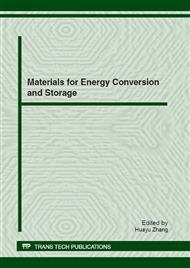[1]
F.M. Gray, Polymer electrolytes, The Royal Society of Chemistry, London, 1997.
Google Scholar
[2]
K. Xu, Nonaqueous Liquid Electrolytes for Lithium-Based Rechargeable Batteries, Chem Rev. 104 (2004) 4303-4417.
DOI: 10.1021/cr030203g
Google Scholar
[3]
J.M. Tarascon, M. Armand, Issues and challenges facingrechargeable lithium batteries, Nature 414 (2001) 359-367.
DOI: 10.1038/35104644
Google Scholar
[4]
D.E. Fenton, J.M. Parker, P.V. Wright, Complexes of alkali-metal ions with poly(ethylene oxide), Polymer 14 (1973) 589-589.
DOI: 10.1016/0032-3861(73)90146-8
Google Scholar
[5]
M. Armand, The history of polymer electrolytes, Solid State Ionics. 69 (1994) 309-319.
DOI: 10.1016/0167-2738(94)90419-7
Google Scholar
[6]
P.V. Wright, Developments in polymer electrolytes for lithium batteries, MRS Bull. 27 (2002) 597-602.
DOI: 10.1557/mrs2002.194
Google Scholar
[7]
F. Croce, G.B. Appetecchi, L. Persi, B.Scrosati, Nanocomposite polymer electrolytes for lithium batteries, Nature 394 (1998) 456-458.
DOI: 10.1038/28818
Google Scholar
[8]
L.Z. Fan, Z.M. Dang, C.W. Nan, M. Li, Thermal, electrical and mechanical properties of plasticized polymer electrolytes based on PEO/P(VDF-HFP) blends, Electrochim. Acta. 48 (2002) 205-209.
DOI: 10.1016/s0013-4686(02)00603-5
Google Scholar
[9]
C.W. Nan, L.Z. Fan, Y.H. Lin, Q. Cai, Enhanced Ionic Conductivity of Polymer Electrolytes Containing Nanocomposite SiO2 Particles, Phys. Rev. Lett. 91 (2003) 2661041-2661044.
Google Scholar
[10]
A. Nishimoto, M. Watanabe, Y. Ikeda, et al., High ionic conductivity of new polymer electrolytes based on high molecular weight polymer comb polymers, Electrochim. Acta. 43 (1998) 1177-1184.
DOI: 10.1016/s0013-4686(97)10017-2
Google Scholar
[11]
M. Watanabe, T. Endo, A. Nishimoto, et al., High ionic conductivity and electrode interface properties of polymer electrolytes based on high molecular weight branched polyether, J Power Sources. 82 (1999) 786-789.
DOI: 10.1016/s0378-7753(99)00250-5
Google Scholar
[12]
Y. Ikeda, Y. Wada, Y. Matoba, S. Murakami, S. Kohjiya, Characterization of comb-shaped high molecular weight poly(oxyethylene) with tri(oxyethylene) side chains for a polymer solid electrolyte Electrochim. Acta. 45 (2000) 1167-1174.
DOI: 10.1016/s0013-4686(99)00377-1
Google Scholar
[13]
J.-S. Chung, H.-J. Sohn, Electrochemical properties of amorphous comb-shaped composite PEO polymer electrolyte, J. Power Sources. 112 (2002) 671-675.
DOI: 10.1016/s0378-7753(02)00484-6
Google Scholar
[14]
A. Chakrabarti, A. Juilfs, R. Filler, B.K. Mandal, Novel PEO-based dendronized polymers for lithium-ion batteries, Solid State Ionics 181 (2010) 982-986.
DOI: 10.1016/j.ssi.2010.05.016
Google Scholar
[15]
A. Vallee, S.Besner, J.Prudhomme, Comparative-study of poly(ethylene oxide) electrolytes made with LiN(CF3SO2)2 and LiClO4 thermal properties and conductivity behavior, Electrochim. Acta. 37 (1992) 1579-1583.
DOI: 10.1016/0013-4686(92)80115-3
Google Scholar
[16]
S. Ahmad, Polymer electrolytes: characteristics and peculiarities, Ionics. 15 (2009) 309-321.
Google Scholar
[17]
T. Ouchi, H. Yuyama, T. Inui, et al., Synthesis of polyether-bound-3-(5-fluorouracil-1-yl) propanoic acid and its hydrolysis reactivity, Eur. Polym. J. 22 (1986) 537.
DOI: 10.1016/0014-3057(86)90180-1
Google Scholar
[18]
A. Biegle, J.C. Galin, Matrix polarity effects on microphase separation in zwitterionomers, Macromol. Chem. Phys. 13 (2000) 1442-1450.
DOI: 10.1002/1521-3935(20000801)201:13<1442::aid-macp1442>3.0.co;2-2
Google Scholar
[19]
J.C. Ronda, J.A. Reina, V. Cadiz, et al., Self-Organized Liquid-Crystalline Polyethers Obtained by Grafting Tapered Mesogenic Groups onto Poly(epichlorohydrin): Toward Biomimetic Ion Channels, Journal of Polymer Science: Part A: Polymer Chemistry 41 (2003) 2918-2929.
DOI: 10.1002/pola.10888
Google Scholar
[20]
D.Linden, Handbook of Batteries, 2nd Ed. McGraw-Hill, New York, 1995.
Google Scholar
[21]
X.Q. Yang, J.Y. Han, P.X. Li, C.Q. Xu, Y.H. Guo, Study on the industry-applied properties of alkylethercarboxylates, China Surfactant Detergent & Cosmetics 31 (2001) 5-8.
Google Scholar
[22]
H. Huang, Study of physico-chemical properties of alkylether carboxylic acids and their salts, Advances in Fine Petrochemicals 04 (2003) 19-23.
Google Scholar
[23]
W.A. Gazotti, M.A.S. Spinace, E.M. Girotto, M.A.De Paoli, Polymer electrolytes based on ethylene oxide–epichlorohydrin copolymers, Solid State Ionics 130 (2000) 281-291.
DOI: 10.1016/s0167-2738(00)00550-6
Google Scholar
[24]
Y. Ikeda, H. Masui, Y. Matoba, Ionic conductivity of polymer solid electrolyte prepared from poly[epichlorohydrin-co-(ethylene oxide)] of high ethylene oxide content, J. Applied Polymer Science. 95 (2005) 178-184.
DOI: 10.1002/app.20814
Google Scholar
[25]
X. L. Wang, L. Z. Fan, A. Mei, et al., Ionic transport behavior in poly(ethylene oxide)–poly(propylene oxide)–poly(ethylene oxide) and LiClO4 complex, Electrochim. Acta. 53 (2008) 2448-2452.
DOI: 10.1016/j.electacta.2007.10.022
Google Scholar
[26]
Y. Zhao, R.Tao, T. Fujinami, Enhancement of ionic conductivity of PEO-LiTFSI electrolyte upon ncorporation of plasticizing lithium borate, Electrochim. Acta. 51 (2006) 6451-6455.
DOI: 10.1016/j.electacta.2006.04.030
Google Scholar
[27]
I.W. Cheung, K.B. Chin, E.R. Greene, M.C. Smart, S.Abbrent, S.G. Greenbaum, G.K.S. Prakash, S. Surampudi, Electrochemical and solid state NMR characterization of composite PEO-based polymer electrolytes, Electrochim. Acta. 48 (2003) 2149-2156.
DOI: 10.1016/s0013-4686(03)00198-1
Google Scholar
[28]
B. K. Choi, Y. W. Kim, Conductivity relaxation in the PEO-salt polymer electrolytes, Electrochim. Acta. 49 (2004) 2307-2313.
DOI: 10.1016/j.electacta.2004.01.011
Google Scholar


